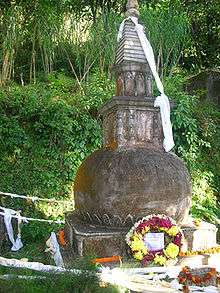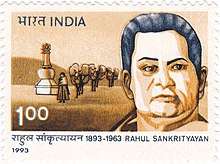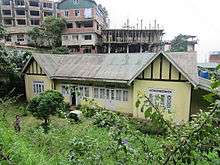Rahul Sankrityayan
Rahul Sankrityayan (9 April 1893 – 14 April 1963), is called the Father of Indian Travelogue Travel literature. He is the one who played a pivotal role to give travelogue a 'literature form', was one of the most widely travelled scholars of India, spending forty-five years of his life on travels away from his home.[1]
Rahul Sankrityayan | |
|---|---|
Bust of Sankrityayan in Darjeeling, India | |
| Born | April 9, 1893 Azamgarh, Uttar Pradesh |
| Died | 14 April 1963 (aged 70) Darjeeling, West Bengal, India |
| Occupation | Writer, essayist, scholar, sociology, indian nationalist, history, Indology, philosophy, Buddhism, Tibetology, Lexicography, Grammar, Textual Editing, Folklore, Science, drama, Politics, Polymath, Polyglot |
| Nationality | Indian |
| Notable awards | 1958: Sahitya Akademi Award 1963: Padma Bhushan |
He travelled to many places and wrote many travelogue approximately in the same ratio. He is also famously known for his authentic description about his travels experiences, for instance- in his travelogue "Meri Laddakh Yatra" he presents overall regional, historical and cultural specificity of that region judiciously. He became a Buddhist monk (Bauddha Bhikkhu) and eventually took up Marxist Socialism.[1] Sankrityayan was also an Indian nationalist, having been arrested and jailed for three years for creating anti-British writings and speeches.[1] He is referred to as the 'Greatest Scholar' (Mahapandit) for his scholarship.[1] He was both a polymath as well as a polyglot.[1] The Government of India awarded him the civilian honour of the Padma Bhushan in 1963.[2]
Childhood
He was born as Kedarnath Pandey in a [Brahmin family, Gotra-Sankritya] on 9 April 1893 in Pandha Village and his ancestral village is Kanila Chakarpanur village, Azamgarh district, in Eastern Uttar Pradesh.[3] He received formal schooling at a local primary school, though he later studied and mastered numerous languages independently, as well as the art of photography.
Philosophy of his Life
In his initial days he was a keen follower of Arya Samaj of Swami Dayananda Saraswati. Buddhism came to him and changed his life. After taking Diksha in Sri Lanka he become Rahul(son of Budda) also used his Gotra (Sankritya) with his name and finally called “Rahul Sankrityayan”. He lost faith in God's existence but still retained faith in reincarnation. Later he moved towards Marxist Socialism and rejected the concepts of reincarnation and afterlife also. The two volumes of Darshan-Digdarshan, the collected history of World's Philosophy give an indication of his philosophy when we find the second volume much dedicated to Dharmakirti's Pramana Vartika. This he discovered in Tibetan translation from Tibet.
Travels
Sankrityayan's travels took him to different parts of India including Ladakh, Kinnaur, and Kashmir. He also travelled to several other countries including Nepal, Tibet, Sri Lanka, Iran, China, and the former Soviet Union. He spent several years in the "Parsa Gadh" village in the Saran district in Bihar. The village's entry gate is named "Rahul Gate". While travelling, he mostly used surface transport, and he went to certain countries clandestinely; he entered Tibet as a Buddhist monk. He made several trips to Tibet and brought valuable paintings and Pali and Sanskrit manuscripts back to India. Most of these were a part of the libraries of Vikramshila and Nalanda Universities. These objects had been taken to Tibet by fleeing Buddhist monks during the twelfth and subsequent centuries when the invading Muslim armies had destroyed universities in India. Some accounts state that Rahul Sankrityayan employed twenty-two mules to bring these materials from Tibet to India. Patna Museum, Patna, has a special section of these materials in his honour, where a number of these and other items have been displayed.
Books
Sankrityayan was a polyglot, well versed in several languages and dialects, including Hindi, Sanskrit, Pali, Bhojpuri, Magahi, Urdu, Persian, Arabic, Tamil, Kannada, Tibetan, Sinhalese, French and Russian.[1] He was also an Indologist, a Marxist theoretician, and a creative writer.[1] He started writing during his twenties and his works, totalling well over 100, covered a variety of subjects, including sociology, history, philosophy, Buddhism, Tibetology, lexicography, grammar, textual editing, folklore, science, drama, and politics.[1] Many of these were unpublished.[1] He translated Majjhima Nikaya from Prakrit into Hindi.[1]

One of his most famous books in Hindi is Volga Se Ganga (A journey from the Volga to the Ganges) – a work of historical fiction concerning the migration of Aryans from the steppes of the Eurasia to regions around the Volga river; then their movements across the Hindukush and the Himalayas and the sub-Himalayan regions; and their spread to the Indo-Gangetic plains of the subcontinent of India. The book begins in 6000 BC and ends in 1942, the year when Mahatma Gandhi, the Indian nationalist leader called for the quit India movement. It was published in 1942. A translation into English of this work by Victor Kiernan was published in 1947 as From Volga to Ganga.[4] It was translated by K.N. Muthiya-Tamilputhakalayam in Tamil as Valgavil irundu gangai varai and is still considered a best-seller. The Kannada translation done by B.N Sharma as "Volga Ganga" . The Telugu translation (Volga nunchi Ganga ku) inspired many readers. Volga muthal Ganga vare, the Malayalam translation, became immensely popular among the young intellectuals of Kerala and it continues to be one of the most influential books of its times. The Bengali version is Volga Theke Ganga [ভল্গা থেকে গঙ্গা], which is still acclaimed by the critics.
His most important travelogue literature is- "Tibbat me Sava varsha(1933), "Meri Europe Yatra" (1935), "Athato Ghumakkad Jigyasa", "Volga se Ganga", "Asia ke Durgam Bhukhando Mein", "Yatra Ke Panne" and "Kinnar Desh Mein".
More than ten of his books have been translated and published in Bengali. He was awarded the Padmabhushan in 1963,[5] and he received the Sahitya Akademi Award in 1958 for his book Madhya Asia ka Itihaas.
He maintained daily diaries in Sanskrit which were used fully while writing his autobiography. In spite of profound scholarship, he wrote in very simple Hindi that a common person could follow. He wrote books of varied interest. He was aware of limitations of Hindi literature and singularly made up the loss in no small measure.
The historian Kashi Prasad Jayaswal compared Rahul Sankrityayan with Buddha. Rahul's personality was as impressive and memorable as are his achievements. He traveled widely and wrote in five languages – Hindi, Sanskrit, Bhojpuri, Pāli and Tibetan. His published works span a range of genres, which include autobiography, biography, travelogue, sociology, history, philosophy, Buddhism, Tibetology, lexicography, grammar, text editing, folklore, science, fiction, drama, essays, politics, and pamphleteering.
Soviet Union
Although he had little formal education, in view of his knowledge and command over the subject, University of Leningrad appointed him Professor of Indology in 1937–38 and again in 1947–48.
Contributions
Many of Rahul's personal collections including the ones he gathered from his multiple trips to Tibet were distributed across to multiple Universities and Museums. Patna Museum has an extensive collection of Buddhist scrolls which he assimilated through his journeys across Tibet. Many of these are considered rare gems of Indian scriptures translated into Tibetan.
Personal life and family

Rahul was married when very young and never came to know anything of his child-wife, Santoshi. Probably he saw her only once in his 40s as per his autobiography: Meri Jivan Yatra. During his stay in Soviet Russia a second time, accepting an invitation for teaching Buddhism at Leningrad University, he came in contact with a Mongolian scholar Lola (Ellena Narvertovna Kozerovskaya). She could speak French, English, and Russian and write Sanskrit. She helped him in working on Tibetan- Sanskrit dictionary. Their attachment ended in marriage and birth of son Igor. Mother and son were not allowed to accompany Rahul to India after completion of his assignment due to restrictions imposed by Stalin regime.
Late in life, he married Dr. Kamala, an Indian Nepali lady and had a daughter (Jaya), two sons (Jeta) and (Jayant) .
Death
Rahul accepted a teaching job at a Sri Lankan University, where he fell seriously ill. Diabetes, high blood pressure and a mild stroke struck him. Most tragic happening was the loss of memory. He breathed his last in Darjeeling in 1963.
His last residence at Darjeeling was at 21 Kacheri Road: Rahul Nivas.

Awards
| Awards | About | Awarded By |
|---|---|---|
| Rahul Sankrityayan National Award | Contribution to Hindi travel Literature (also called Travel Litterateur's Honour). | Kendriya Hindi Sansthan, Government of India |
| Mahapandit Rahul Sankrityayan Paryatan Puraskar | Awarded for contributing significantly in the field of travelogue and Discovery and Research in Hindi, for books written originally in Hindi on Tourism related subjects. | Ministry of Tourism, Government of India |
Works
In Hindi
Novels
- Baaeesween Sadi – 1923
- Jeeney ke Liye – 1940
- Simha Senapathi – 1944
- Jai Yaudheya – 1944
- Bhago Nahin, Duniya ko Badlo – 1944
- Madhur Swapna – 1949
- Rajasthani Ranivas – 1953
- Vismrit Yatri – 1954
- Divodas – 1960
- Vismriti Ke Garbh Me
Short Stories
- Satmi ke Bachche – 1935
- Volga Se Ganga – 1944
- Bahurangi Madhupuri – 1953
- Kanaila ki Katha – 1955–56
Autobiography
- Meri Jivan Yatra I – 1944
- Meri Jivan Yatra II – 1950
- Meri Jivan Yatra III, IV, V – published posthumously
Biography
- Sardar Prithvi Singh – 1955
- Naye Bharat ke Naye Neta (2 volumes) – 1942
- Bachpan ki Smritiyan – 1953
- Ateet se Vartaman (Vol I) – 1953
- Stalin – 1954
- Lenin – 1954
- Karl Marx – 1954
- Mao-Tse-Tung – 1954
- Ghumakkar Swami – 1956
- Mere Asahayog ke Sathi – 1956
- Jinka Main Kritajna – 1956
- Vir Chandrasingh Garhwali – 1956
- Simhala Ghumakkar Jaivardhan – 1960
- Kaptan Lal – 1961
- Simhal ke Vir Purush – 1961
- Mahamanav Budha – 1956
Some of his other books are:-
- Mansik Gulami
- Rhigvedic Arya
- Ghumakkar Shastra
- Kinnar desh mein
- Darshan Digdarshan
- Dakkhini Hindi ka Vyaakaran
- Puratatv Nibandhawali
- Manava Samaj
- Madhya Asia ka Itihas
- Samyavad hi Kyon
In Bhojpuri
Plays
- Japaniya Rachhachh
- Des Rachchhak
- Jarmanwā ke hār nihichay
- ī hamār laṛāi'"
- Dhunmum Netā
- Naikī duniyā
- Jonk
- Mehrārun ke durdasā
Related to Tibetan
- Tibbati Bal-Siksha – 1933
- Pathavali (Vol. 1,2 & 3) – 1933
- Tibbati Vyakaran (Tibetan Grammar) – 1933
- Tibbat May Budh Dharm-1948
- Lhasa ki or
- Himalaya Parichay Bhag 1
- Himalaya Parichay Bhag 2
See also
References
- Sharma, R.S. (2009). Rethinking India's Past. Oxford University Press. ISBN 978-0-19-569787-2.
- "Padma Awards" (PDF). Ministry of Home Affairs, Government of India. 2015. Retrieved 21 July 2015.
- Prabhakar Machwe (1 January 1998). Rahul Sankrityayan (Hindi Writer). Sahitya Akademi. pp. 12–. ISBN 978-81-7201-845-0.
- Rahul Sankrityayana From Volga to Ganga, Rahula Publication, Mussorie, 1947.
- "Padma Awards Directory (1954–2013)" (PDF). Ministry of Home Affairs, Government of India.
Further reading
| Wikimedia Commons has media related to Rahul Sankrityayan. |
- Ram Sharan Sharma, Rahul Sankrityayan and Social Change, Indian History Congress, 1993.
- Himalayan Buddhism, Past and Present: Mahapandit Rahul Sankrityayan centenary volume by D. C. Ahir (ISBN 978-81-7030-370-1)
- Prabhakar Machwe: "Rahul Sankrityayan" New Delhi 1978: Sahitya Akademi. [A short biography including a list of Sankrityayan's works]
- Bharati Puri, Traveller on the Silk Road: Rites and Routes of Passage in Rahul Sankrityayan’s Himalayan Wanderlust, China Report (Sage: New Delhi), February 2011, vol. 47, no. 1, pp. 37–58.
- Alaka Atreya Chudal, A Freethinking Cultural Nationalist: A Life History of Rahul Sankrityayan, Oxford University Press, 2016. (ISBN 978-01-9946-687-0)